CTO on Demand: Ultimate Guide to Hiring a Virtual CTO
- Updated: Nov 10, 2024
- 16 min
Are you a founder or serial entrepreneur looking to bring a chief technical officer (CTO) on board your startup? If so, you’ve come to the right place.
In this article, we’ll cover everything you need to know about hiring a CTO, including:
- What exactly a CTO does
- When you should think about hiring one
- The major benefits CTOs offer startups
- Common challenges founders face in the hiring process
- Different options for working with a technical director
- Typical CTO salary and compensation ranges
- Steps for finding and selecting the right CTO for your needs
We’ll break all of this down in simple, straightforward language. Even if you don’t have an engineering background, you’ll walk away better equipped to build an effective technical leadership structure at your young company.
Let’s get started!
Transform your ideas into reality with our experienced CTO — contact us to get started!
What is the Role of a Chief Technical Officer?
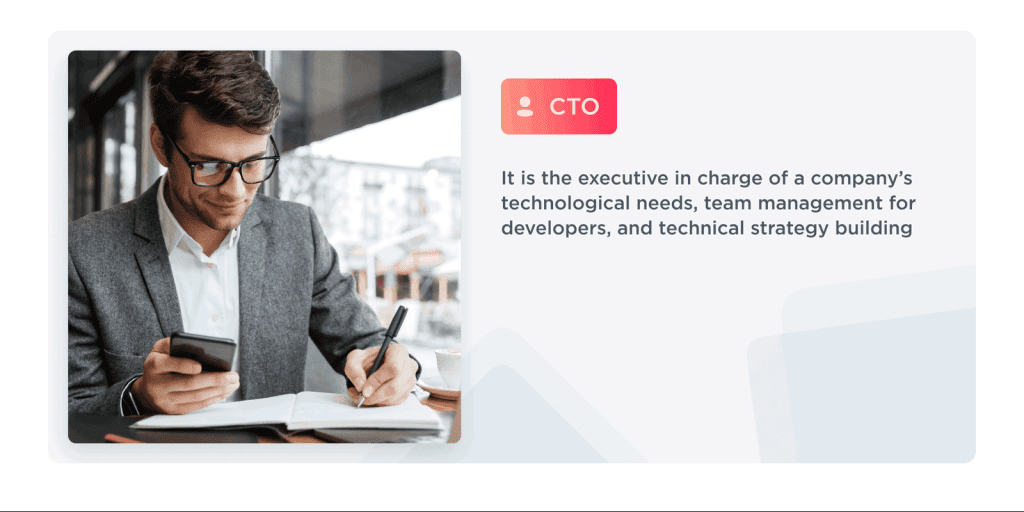
The CTO is a c-level executive overseeing an organization’s technical operations.
They guide other team members, determine which technology to adopt, and map the workflow for all development and maintenance activities.
Zippia research suggests that the US has 23,885 CTOs. A number that’s expected to grow by a 6% CAGR from 2021 to 2023.
Let’s further educate you on what the role entails, and the types of CTO available.
Types of Chief Technical Officers
They are categorized based on the organization’s types and roles. The three types of CTOs are:
- Early-stage technical directors
- Technical directors at startups.
- Late-stage, or large (unicorn) startup technical director,
Each has roles that are distinct from one another. To know what category your CTO needs fall under, we’ll break down what each entails:
| Types of CTO | Description |
| Early-stage technical director | These technical executives work in early-stage startups, contribute towards idea validation, and double as the lead technology manager and senior developer. They’re solely responsible for choosing stacks for the technical team and often have full-service software development expertise. The skills required to function here are
Team members here range from 0-10 tech talents. |
| Technical directors at a startup | These are technical executives in charge of all development and maintenance practices in mid-stage startups. I.e., startups that have raised a series of funding from VCs. A startup CTO with mid-stage startups makes decisions on which technology to adopt or churn out and identifies talents to onboard. Makes decisions regarding budget allocation, regularly audits existing tech stack, and aims at building high-quality solutions at a fast rate. Skills required at this level are
This type of CTO usually manages a team of 10-50 people. This churn rate calculator is a useful tool for SaaS businesses aiming to maintain a stable customer base. |
| Late-stage startup and large (unicorn) startup technical directors | This is the most senior tech executive in large enterprises–usually large-scale startups and unicorns. These CTOs are responsible for improving business profitability, creating a long-term technical strategy, and onboarding tech lead and senior developers. They also maintain all product architectures, maintaining a competitive edge and ensuring talents master new technologies. Skills required to function here are:
This type of CTO is usually in charge of a team of over 50 employees. |
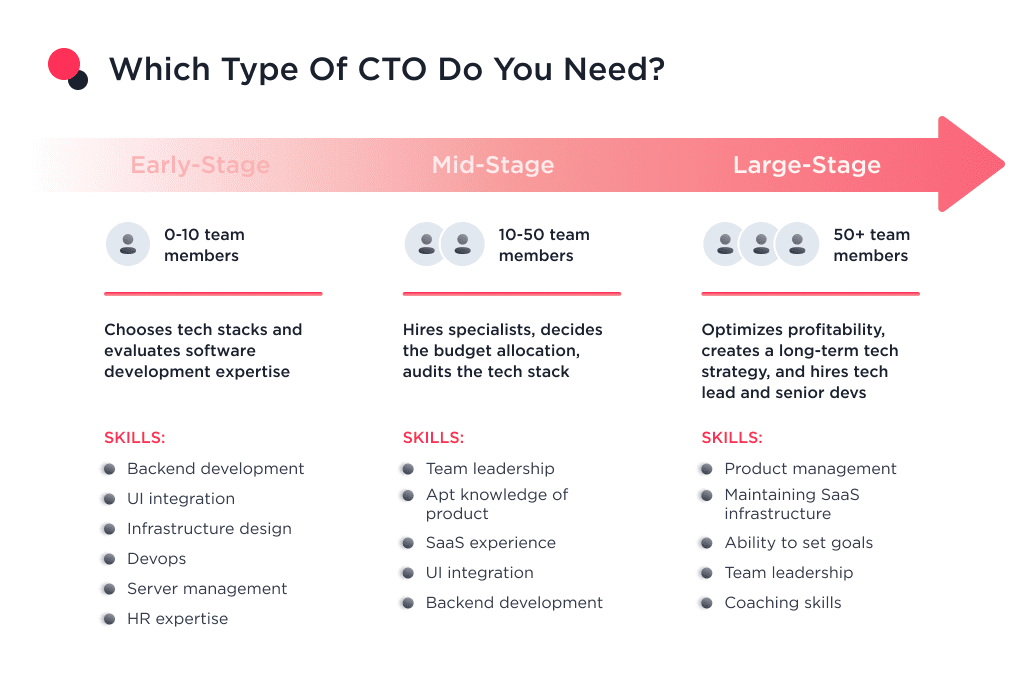
A popular misconception is that CTOs are co-founders.
While in some cases this is not always the case. In fact, for most unicorns, CTOs are employed like other team members.
Let’s break down how both titles differ.
Difference Between a Technical Co-Founder and a CTO
It’s a common misconception to assume CTO, and Technical Co-founders work in the same position. Here’s how they differ:
| Technical Co-founder | CTO |
| Technical co-founders or technical partners are developers hired by startup founders for that role. Learn how to find a technical co-founder. Technical-co founders have a flexible contract that allows startups to delay payment until the company goes public, raises funds, or becomes profitable. Responsibilities of a technical cofounder entail managing and expanding the engineering team, having a product strategy, managing MVP production, and drawing up project tech stack. Learn more about MVP in software development. | This is an executive-level staff of the company that’s in charge of all technical processes it embarks on. Generally, the CTO title is used by tech-centric companies creating software products. The responsibilities of a CTO entail team management, defining tech stacks in an organization, managing technical operations, and tracking performance KPIs for the technical team. |
Usually, startups can’t afford to hire a qualified chief technology officer.
And since hiring a professional that’ll opt for a future unguaranteed payment is unlikely, they opt for a more flexible option–-CTO on demand. 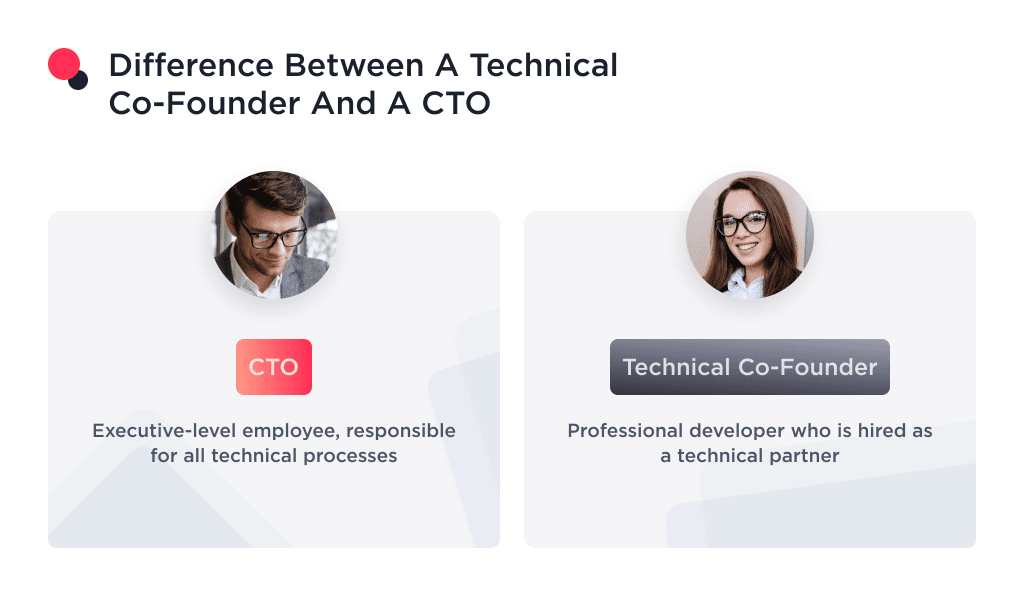
Now that you know what CTO stands for, when exactly do you need one?
Let’s discuss this.
Best Time to Hire a CTO
Before you search CTO for a startup online or via your connection, you should first ascertain that you need one.
Before embarking on such a significant hire, here are things to consider:
1. You Need a Tech Executive to Guide Development Team
It’s time to hire a CTO if you have a large team and need a tech executive with in-depth knowledge of software infrastructure management and tech trends in your niche.
2. You Want to Scale Your Business
You should hire a CTO if you’re at a point where your startup is stable and generating revenue, but you need extra effort to scale your offerings.
A Chief Technical Officer will help manage your scaling process by ensuring you use exemplary architecture, build resilient features, and adjust your technology to handle desired growth.
3. You Lack Knowledge of Technical Processes
A lack of technical knowledge can hinder the capacity to monitor and manage your dedicated development team.
Hire a Chief Technical Officer who understands the operations and can determine the right technology for your startups. 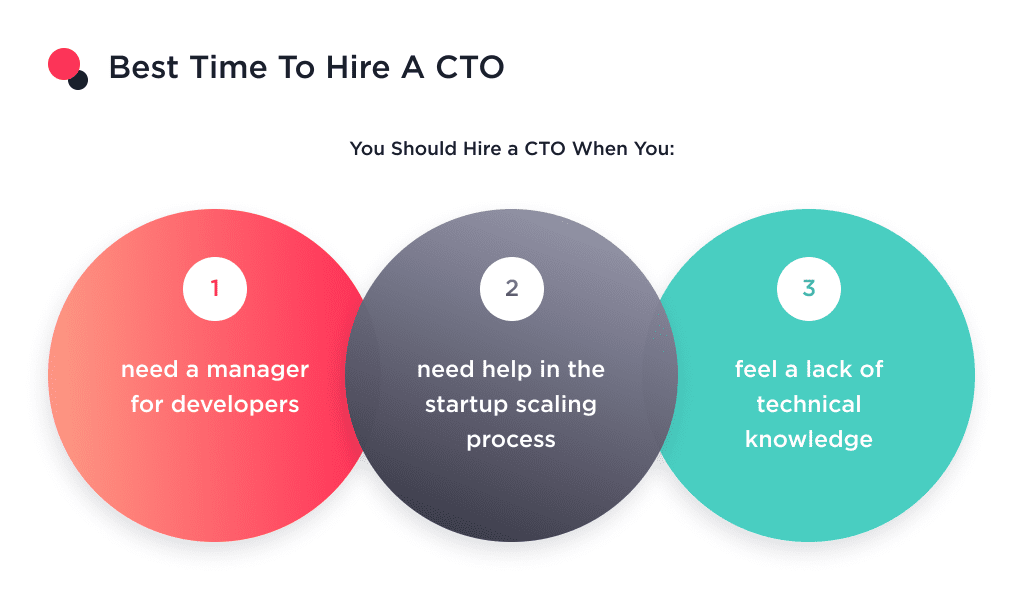
You’re probably wondering what benefit you get from hiring a CTO.
Let’s educate you on this.
Benefits of Hiring a CTO
Hiring a CTO helps your startup have a streamlined development and maintenance strategy.
Beyond that, it also ensures your company works at optimum effectiveness by ensuring the following:
1. Development of High-Quality Tech Products
Hiring a seasoned CTO helps you benefit from their years of experience to create high-quality, scalable, and resilient solutions.
CTOs understand the intricacies, code syntax, software infrastructure, and features required to improve the quality of your product.
2. Time Savings and More Flexibility
CTOs help saves time by providing quick solutions to technical pain points.
They ensure codes written are simple and of excellent quality.
Thus, reducing maintenance time and eliminating the need for future code revamps.
Also, you can hire CTO-on-demand for a specified timeframe, as opposed to in-house specialists that you’ll have to hire even during unproductive periods.
3. Provides Objective Opinions
CTOs can give different and sometimes better insight into a technical or business model.
Since they’re professionals, who usually have years of experience working on multitudes of architectures, the opinions they offer can help you edge out competitors.
4. Getting Started Without Training
Investopedia reports that most CTOs have over 15 years of experience, which makes them accustomed to all development and maintenance processes.
As such, they can start adding value to your project and team without prior training.
5. Deployment of New Technologies
Most CTOs have experience in deploying new technologies and avoid regular unplanned downtimes via incremental testing.
They grasp multiple programming languages and can easily suggest a new technology that guarantees improved speed and security. 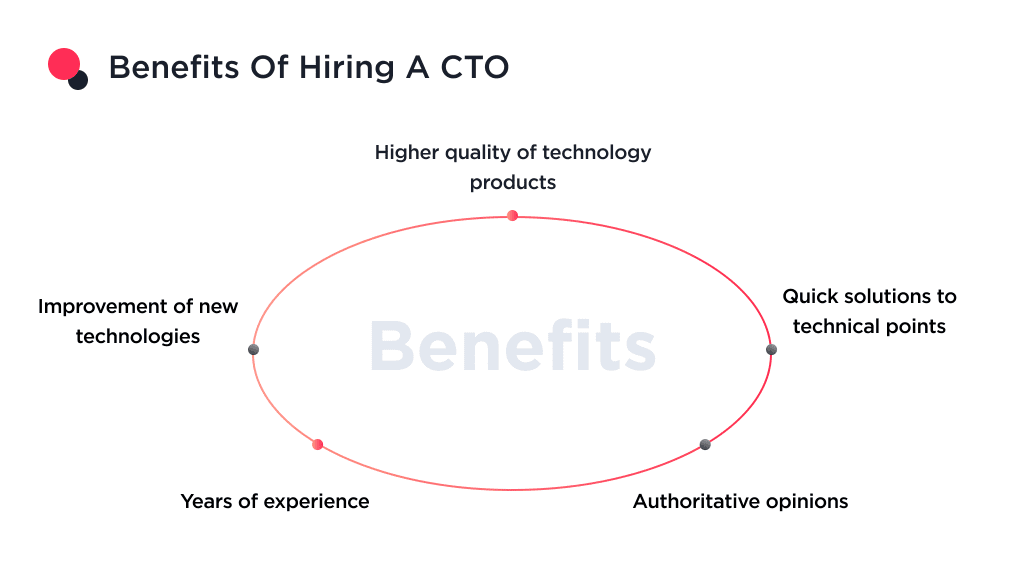
Now that you know the pros of hiring a CTO for your startup, it’s worth noting that it is not always a smooth sail.
There are challenges to hiring a CTO, which we’ll discuss below.
Fuel your startup's growth with tailored mobile apps.
Challenges of Hiring a CTO
As with any hiring plan, there are always challenges to surmount. For CTOs, startups’ common hiring challenges are:
- High salary expectations from potential candidates,
- Lack of enthusiasm for working in a startup,
- The small talent pool,
- Cultural differences,
- Trust issues.
Let’s help you understand these issues.
1. High Salaries
According to TechCrunch, CTOs earn more than CEOs for early-stage startups.
This exorbitant fee is a significant challenge for startups as hiring an experienced CTO requires a huge budget.
For example, hiring an experienced chief technical officer in the US may cost as much as $250k/year.
This is beyond the budget of many startups, even some investment-backed enterprises.
2. Lack of Interest in Startups
A survey by Zippia shows that less than 17% of CTOs work for small-scale startups. Coincidentally, over 99% of US startups are categorized as small businesses.
These two statistics show that most CTOs have a preference for working with fully-established enterprises over startups.
Some reasons for this are due to the prospect of job security, better pay, and a more robust development and maintenance budget.
3. Lack of Experienced Talent
Forbes estimates that the current tech talent shortage will reach 4.3 million by 2030. This shortage is due to the high requirements needed to become a CTO.
It’s one that requires top-notch expertise in a relevant tech stack, an understanding of software architectures, and the ability to lead and direct the technical team.
This is a significant challenge for those finding CTO for a startup company as there are few options to choose from.
Consequently, companies are beginning to look toward onboarding talents from abroad.
Particularly through software development agencies with verifiable proof of excellence.
4. Cultural Differences
Cultural differences usually exist between in-house teams and outsourced CTO-on-demand from software development agencies.
This is particularly evident in cooperation between startups in the west and offshore CTOs from India and Africa.
These differences may lead to non-verbal communication barriers, workplace conflicts, and an inability for the CTO to mentor and direct other team members.
5. Trust Issues
Due to the sensitivity of the duties of CTOs, they tend to clash regularly with startup founders due to trust issues. A major mistake from the chief technical officer may result in a data breach or downtime.
Thus, founders find it challenging to place absolute trust in a CTO–particularly new hires. 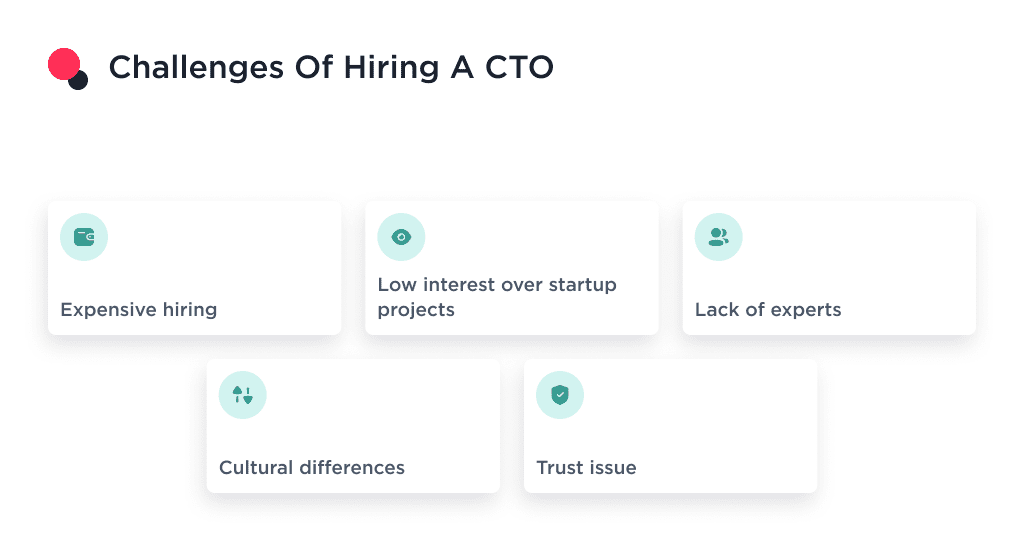
CTO Hiring Options
There are many hiring models to explore. Common CTO hiring models available are
- In-house hiring,
- Technical-director-as-a-service,
- Part-time consultant,
- Outsourcing.
The most suitable model for you depends on your corporate goals, company type, budget, etc.
Let’s help you make sense of what each entails so you can make more informed decisions.
1. In-House Hiring
This hiring model entails onboarding a chief technical officer through traditional means as a full-time CTO, receiving enumeration from the startup, and reporting directly to the CEO.
The CTO here is an employee of the startup.
This model is more suitable for large enterprises and startups with unlimited budgets that want to keep core management activities indoors.
Consider the following pros and cons before opting for this option.
-
Pros and Cons of In-house Hiring
| Pros | Cons |
|
|
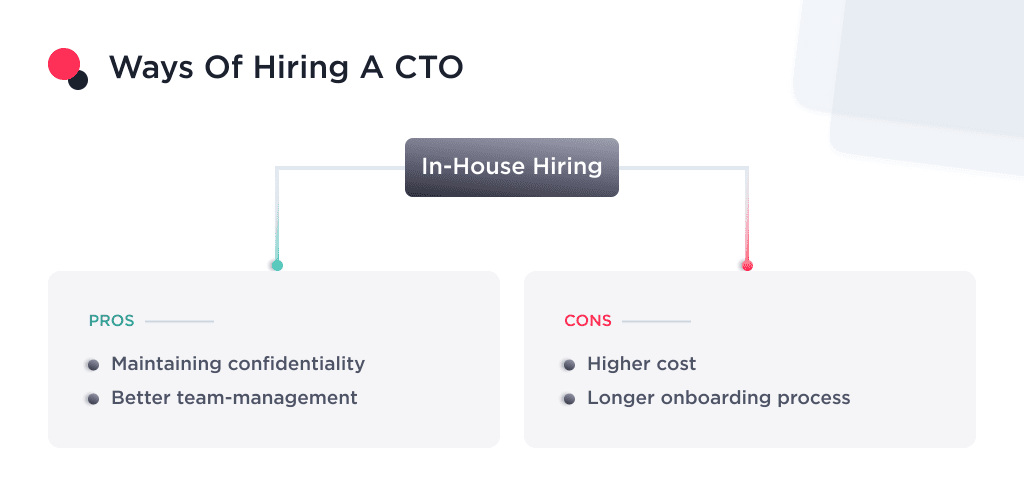
Another option to consider is freelance CTOs, more technically called technical-director-as-a-service. Let’s dig in.
2. Freelance or CTO-as-a-Service
Freelance CTOs are independent professionals that manage a startup’s technical per-contract basis.
They’re individuals open to working with any organization for a stipulated time frame and projects.
This hiring model is suitable for startups with uncertain finances who want a flexible CTO for a specific project.
As with in-house hiring, this model also has its pros and cons.
-
Pros and Cons of Technical Director as a Service
| Pros | Cons |
|
|
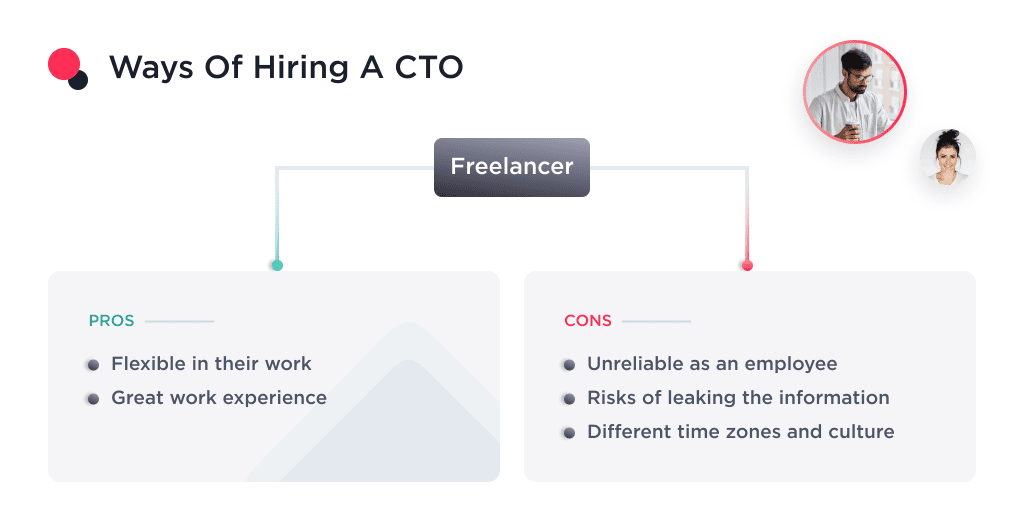
Another important option we’ll consider is outsourcing from a software development company.
3. Outsourcing
This process entails hiring a CTO from a software vendor to manage internal technical employees, determine the roadmap for development processes, advise the CEO during decision-making processes, and coach team members.
This hiring model is best for companies that want a cost-effective yet flexible means of hiring CTO without the cons of freelance-as-a-service.
For a better understanding of this option, we’ll discuss its pros and cons.
-
Pros and Cons of Outsourcing
| Pros | Cons |
|
|
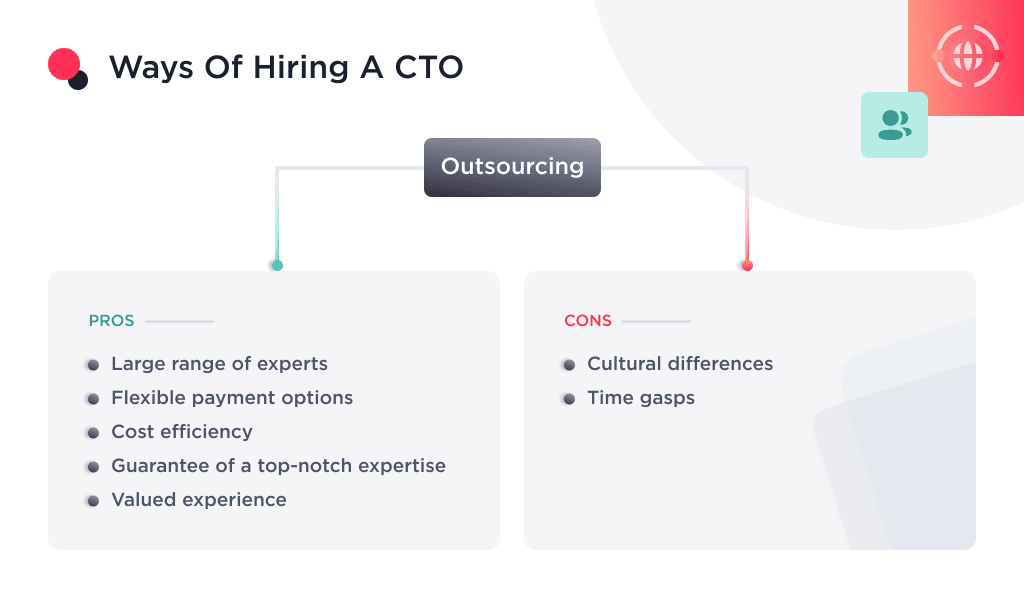
Beyond outsourcing, another popular but less cost-effective option to consider is part-time consulting.
Let’s educate you on this.
4. Part-Time Consultant
Part-time consultant CTOs are professional tech executives working remotely or on-site for a stipulated time, usually less than a full-time employee, to achieve a specified project.
Unlike other hiring options where a CTO has to be regularly available, this expert can only be accessed at specified hours.
This hiring model is ideal for startups using low-code or no-code tools and those using minimal technology.
This option also has its pros and cons that you should consider.
-
Pros and Cons of Hiring a Part-time Consultant CTO
| Pros | Cons |
|
|
Considering the pros and cons elucidated in the four options above, there’s no doubt that outsourcing from a reputable software development agency offers the best cost-quality ratio. 
Now that you better understand what each hiring model entails, let’s discuss the price you’ll pay when you finally find CTO for your business.
How Much Does it Cost to Hire CTO?
The cost of hiring a CTO ranges between $100k to $250k. The exact figure it’ll cost you is determined by:
- The technical skills of the professional,
- Location of the CTO
- The CTO’s level of experience,
- The type of cooperation model.
Let’s break down what each factor entails and how they affect cost.
1. Cost by Location
The location of a CTO is a huge factor to consider in cost.
CTOs from low and middle-income countries tend to be cheaper than those from high-income nations like the UK, US, Canada, etc.
This cost disparity exists even where the professionals have the same skill set.
Here’s how CTOs in different countries stack against each other.
For each figure, we’ll assume you’re hiring a highly-skilled and experienced tech executive:
| County | Cost, $ (Hourly) |
| USA | 146 |
| UK | 125 |
| Canada | 130 |
| Australia | 120 |
| Western Europe | 110 |
| Ukraine | 70 |
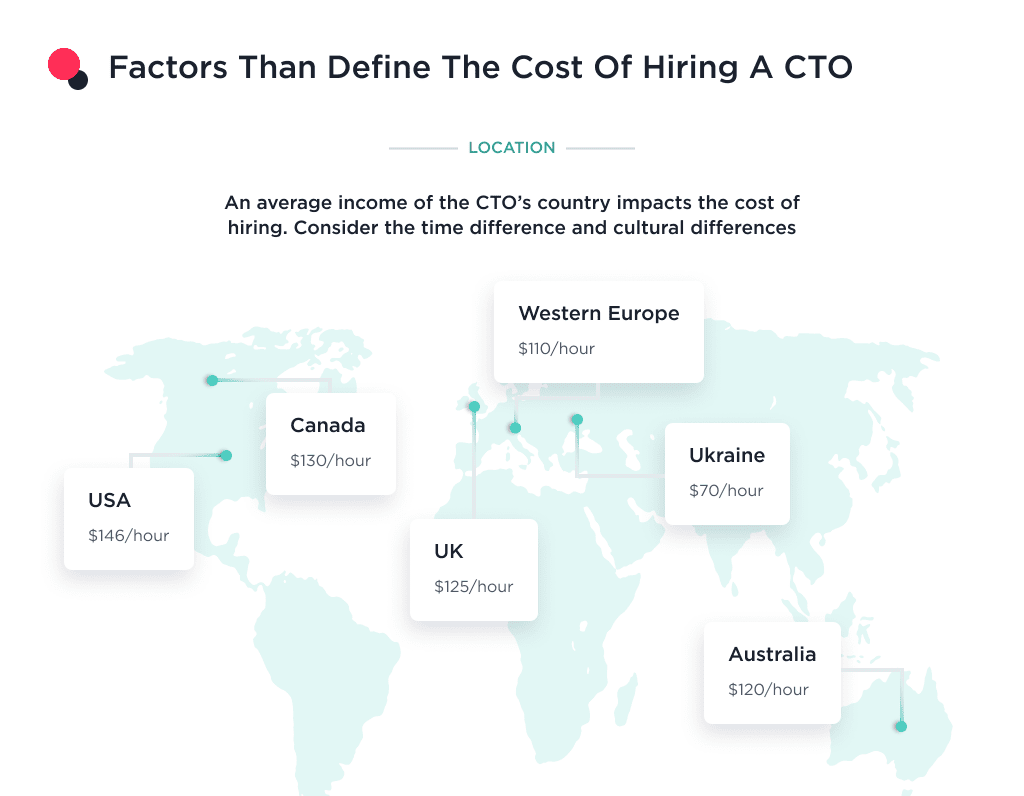
Ukraine is often the best choice for many startups in the west, as they have similar cultural practices and minimal time-zone differences.
Their developers also have a good grasp of the latest technologies.
Ukrainian-based software development agencies also offer a broad range of services other than CTO-on-demand, and core coding process.
Another cost-defining factor to consider is the developers’ level of experience.
2. Cost by Experience Level
The fee paid for a CTO position varies according to the expert’s experience.
Here’s how costs stack up per experience:
| Level | Years of technical experience | Cost (Annual) |
| Senior CTO | 10+ | $143k-$200k |
| Mid-level CTO | 4-9 | $120k-$142k |
| Junior CTO | 1-4 | $110k-$119k |
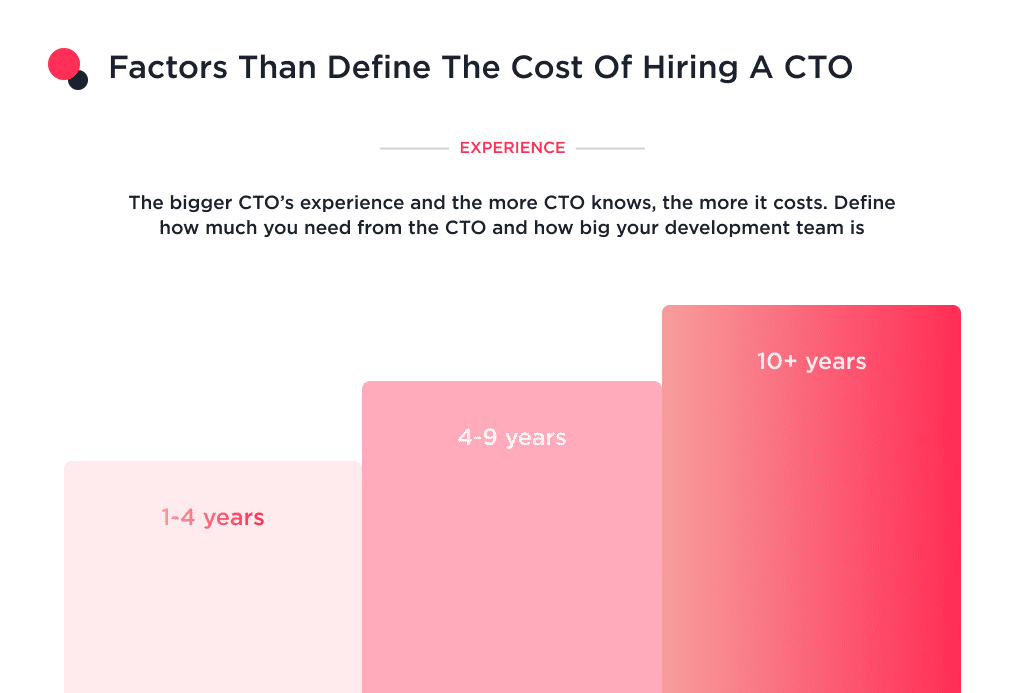
The right candidate for your startup depends on the complexity of your product development and the number of technical team members.
Startups with highly complex projects and a robust team of 50+ developers require a senior CTO.
A junior CTO and a team of less than ten technical experts are ideal for minimalist projects.
Another important cost-defining factor to consider is the type of cooperation model.
What do we mean by this, and how do they differ?
3. Cost by Cooperation Model
The cooperation model of choice is another cost-defining factor to consider.
When it comes to hiring a CTO, the most prominent cooperation models are in-house, freelance, outsourcing, and part-time consulting.
Here’s a table depicting the cost implication of each model:
| Cooperation Model | Cost, $ (Hourly) |
| In-house | 147 |
| Freelance | 90 |
| Outsourcing | 50 |
| Part-time consulting | 160 |

Now that you’re conversant with factors affecting the cost of hiring a CTO let’s discuss how to hire a CTO for a startup.
How to Hire a CTO for Your Startup
To hire the right person with the ideal technical expertise for your startup, it’s best to first:
- Search CTO for startup online and offline
- Outline requirements by stakeholders
- Examine case studies and portfolios,
- Identify control points,
- Sign NDA.
The first step is finding a CTO online or tapping into your network of friends.
Where to Find a CTO
The most popular way to search CTO for a startup is online.
There’s also an offline method, which requires tapping into your network of talents for a referral.
Here’s a list of common platforms to find a CTO:
| Where to Find | Details |
| Freelance platforms | You can fine-tune your search to find CTOs on common freelance sites like Fiverr, Upwork, Toptal, etc. |
| LinkedIn is the largest professional network of professionals on the internet. What’s more? It lets you streamline your search based on experience, location, tech stack, etc. | |
| Online meetings | Online meetings don’t just provide you an avenue to discuss with talents, you can also network with other professionals and find one that suits your corporate needs. |
| Your network | Over 30% of new hires are referred. As such, it’s still the most trusted traditional way to hire talents. Discuss with business partners, subordinates, and others within your network about your needs. |
| Search engine platforms | By simply typing “find CTO for startup” or “hire virtual CTO for a startup,” you’ll get a number of pages on the internet offering you their service. |
| Business listing | Business listings like Clutch can provide you with a list of companies offering a specifically needed service. You may streamline your search to software development agencies in the desired country. Check out the best countries to outsource software development for top choices. |
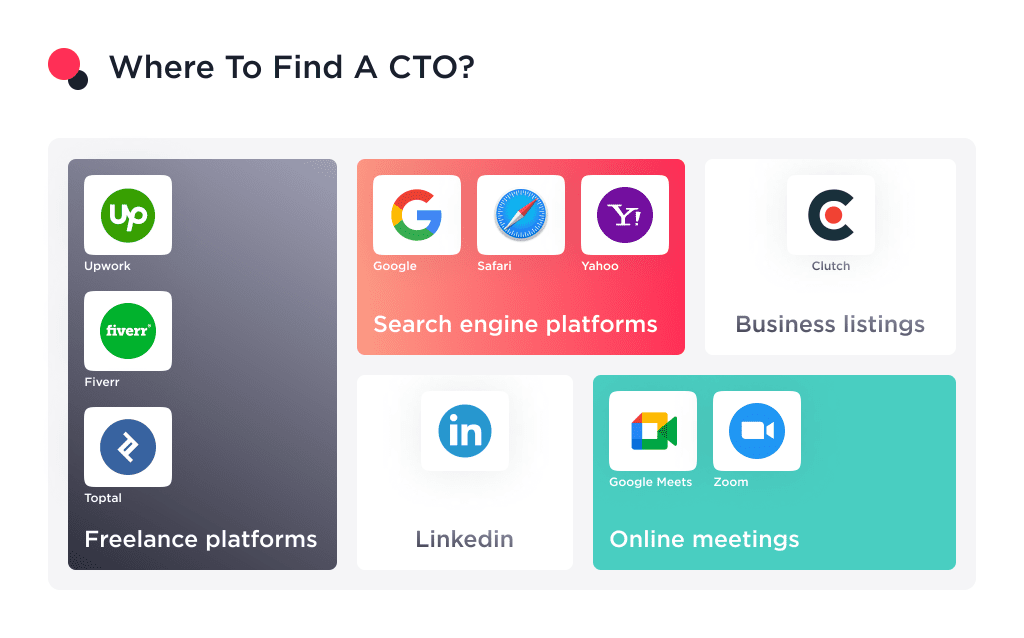
Once you’ve found a suitable CTO to hire, the next step is to begin the vetting and interview process.
How to Choose the Best CTO
Choosing an ideal CTO can be very challenging. You’ll need to vet their claims and check their technical expertise and soft skills to know if they’ll deliver as expected.
Here are the steps to choosing an ideal CTO.
Step 1. Set Clear Requirements
Research the ideal qualities your company needs in a CTO and use them to set job requirements.
Determine what the right candidate will look like.
What soft skills do they possess? What experience should they have?
Consider including the following in your job description:
- A CTO with software engineering expertise and has embarked on multiple projects.
- Someone with experience surmounting the challenge you aim to solve. For example, if you’re trying to scale your product usage, then a CTO with experience doing that helps.
- Someone with experience in multiple technologies, both front-end and back-end tech stacks.
- Opt for a CTO with great programming skills.
Once you’ve set your requirements, check out the portfolios of the professionals to vet their expertise.
Step 2. Examine Case Studies and Portfolios
Case studies are a record of work done on a project.
They provide details on steps they took to achieve a deliverable, methodologies involved and the timeframe for completion.
Portfolios, on the other hand, provide you access to past projects they’ve handled, so you can independently vet the solution.
The steps taken to develop a product are not described in the portfolio.
This step is essential when outsourcing from a software development agency or hiring a freelancer.
Step 3. Identify Control Points
Control points are specific areas you’ve highlighted as the ideal criteria that a prospective CTO should meet and agree to before being hired.
Common control points to consider are:
| Control Points | Details |
| Location | Which region do you want to hire from? And when you choose the country, identify if you want a remote CTO or an on-site one. |
| Technical background. | Do you want a CTO with a technical background in full-stack software engineering, front-end, agile management, etc.? Would you prefer one with experience in mobile app development or web development? Elucidate your technical requirements. |
| Rate | What’s your estimated rate for the role you’re hiring for? Ensure your rate is competitive enough to attract the right CTO. |
| Business acumen | This is the keenness, and ability to deal with corporate situations at a prompt. An ideal CTO should be able to offer timely technological input to resolve business challenges. |
Once you’ve verified your choice, start formalizing your partnership.
For seamless collaboration, knowing what to expect in an app development partnership is essential.
Step 4. Sign NDA
Once you’ve identified a suitable CTO, sign an NDA to prevent them from leaking sensitive information to competitors.
NDAs, an acronym for Non-Disclosure Agreements, is a piece of document restricting an individual from passing information regarding a specific thing to others. 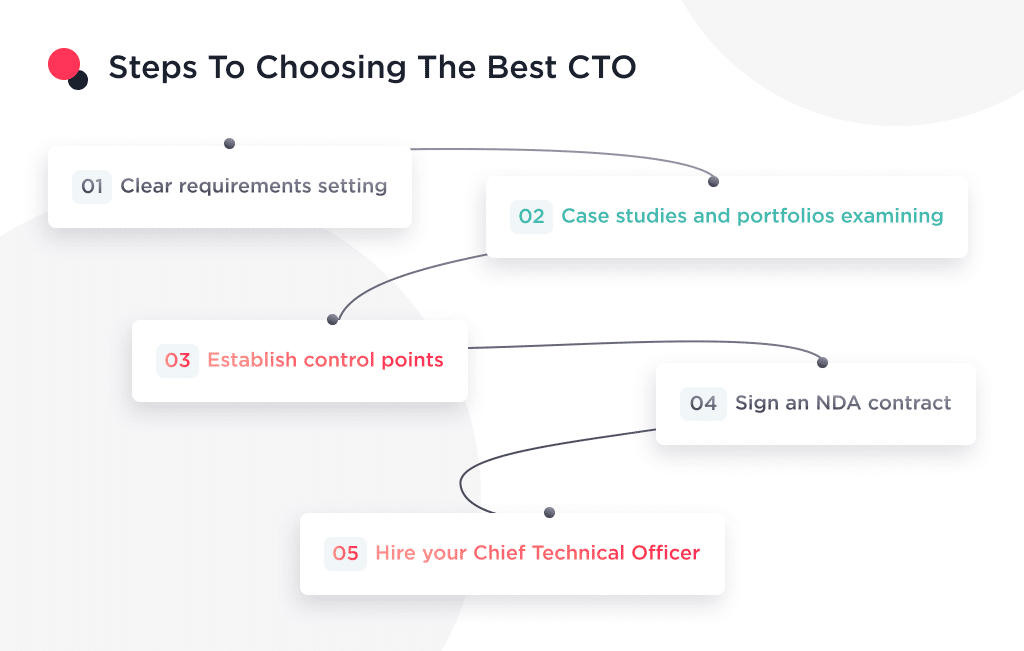
Ready to Hire a CTO?
Hiring a CTO is vital for providing strategic direction to your engineering teams. They instill technical best practices and take product quality to new heights.
If you need an interim CTO or supplemental engineering support, our team can help. We combine Silicon Valley expertise with top Eastern European talent to build robust technology for startups.
Contact us today or check out our Clutch to discuss how we can help you build the next big thing. We offer the technical leadership of an elite Valley CTO through an affordable partnership model.
Need a remote team to support your project? Check out our guide on how to hire a dedicated remote team for top results.













